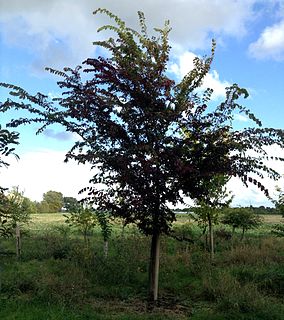Related Research Articles

Ulmus 'Frontier' is an American hybrid cultivar, a United States National Arboretum introduction derived from a crossing of the European Field Elm Ulmus minor with the Chinese Elm Ulmus parvifolia in 1971. Released in 1990, the tree is a rare example of the hybridization of spring- and autumn-flowering elms. Tested in the US National Elm Trial coordinated by Colorado State University, 'Frontier' averaged a survival rate of 74% after 10 years.

The Wych Elm cultivar Ulmus glabra 'Lutescens', commonly known as the Golden Wych Elm, arose as a sport of a wych found in the York area in the early 19th century by W. Pontey of Pontey's nursery, Kirkheaton, Huddersfield, who propagated and distributed it. The original tree he named the Gallows Elm for its proximity to a gallows near York. Loudon in The Gardener's Magazine (1839) identified it as a form of Ulmus montana, adding 'Lutescens' by analogy with Corstorphine sycamore, Acer pseudoplatanus 'Lutescens'.
The Chinese Elm cultivar Ulmus parvifolia 'UPMTF' was raised by Moon's Tree Farm nursery, Atlanta, United States.
The Chinese Elm cultivar Ulmus parvifolia 'Burgundy' is a small American development.

The Chinese Elm cultivar Ulmus parvifolia 'Emer II' or 'Emerald Vase' was cloned from a tree planted circa 1910 on the University of Georgia campus at Athens.
The Chinese Elm cultivar Ulmus parvifolia 'Emer I' or 'Emerald Isle' was cloned from a tree planted circa 1920 on the University of Georgia campus at Athens.
The Chinese Elm cultivar Ulmus parvifolia 'A. Ross Central Park' is probably the hardiest in cultivation and was patented in 1989 by David F. Karnosky. The original tree grew near the entrance to Central Park, at the junction of Fifth Avenue and 72nd Street in the Upper East Side of Manhattan in New York City, and died in the 1990s aged over 100 years. The cloning project was initiated in 1976 by the Arthur Ross Foundation, and executed by the School of Forestry and Wood Products, Michigan Technological University, Houghton.
The Chinese Elm cultivar Ulmus parvifolia 'Dynasty' is a United States National Arboretum introduction reputed to be very fast-growing.

The Chinese Elm cultivar Ulmus parvifolia 'Sempervirens' is an American introduction, commonly known by the synonym 'Evergreen', and may also be in synonymy for U. parvifolia 'Pendens'.
The Chinese Elm cultivar Ulmus parvifolia 'Ohio' was raised by A. M. Townsend at the USDA National Arboretum, and released in 1992.
The Chinese Elm cultivar Ulmus parvifolia 'Todd' was developed by Fleming's Nurseries in Victoria, Australia, and registered in 2001.

The American Elm cultivar Ulmus americana 'Moline' was cloned from a wild seedling transplanted to Moline, Illinois, in 1903 and propagated from 1916 by the Klehm Nurseries, Arlington Heights, IL. Some authorities regard the tree as identical to 'Minneapolis Park'.

The Field Elm cultivar Ulmus minor 'Argenteo-Variegata' or simply 'Variegata', known in Australasia and North America as Silver Elm or Tartan Elm, is said to have been cultivated in France from 1772. Green noted that variegated forms of Field Elm "arise frequently, and several clones may have been known under this name". Dumont de Courset (1802) listed an U. campestris var. glabra variegata, Loudon (1838) an U. nitens var. variegata, and Wesmael (1863) an U. campestris var. nuda microphylla variegata.
The Chinese Elm cultivar Ulmus parvifolia 'Elsmo' was released by the USDA Soil Conservation Service, at Elsberry, Missouri, in 1990 as an open-pollinated, seed-propagated cultivar of extremely variable progeny.
The Chinese Elm cultivar Ulmus parvifolia 'Red Fall' is an American clone selected by S. Bieberich of the Sunshine Nursery, Clinton, Oklahoma.
The Chinese Elm cultivar Ulmus parvifolia 'The Thinker' was selected by M. Hayman from a tree on the campus of the University of Louisville, Kentucky.
The Chinese Elm cultivar Ulmus parvifolia 'BSNUPF' was raised by John Barbour of Athena Trees, Monroe, Georgia.
The Chinese Elm cultivar Ulmus parvifolia 'Burnley Select' was grown from seed taken from a tree at the Burnley (horticultural) College, University of Melbourne and selected by Dr Peter May.
The Chinese Elm cultivar Ulmus parvifolia 'Yarralumla' is a cultivar raised by the Yarralumla Nursery in Canberra, Australia.

The cultivation of elms in Australia began in the first half of the 19th century when British settlers imported species from their former homelands. Owing to the demise of elms in the northern hemisphere as a result of the Dutch elm disease pandemic, the mature trees in Australia's parks and gardens are now regarded as amongst the most significant in the world.
References
- ↑ "Elm Leaf Beetle Survey". Archived from the original on 2011-07-19. Retrieved 17 July 2017.